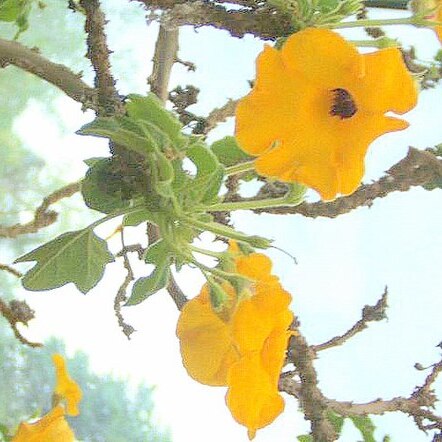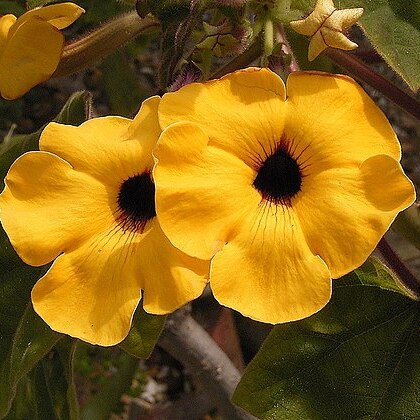Annual or perennial herbs, rarely shrubs or small trees, covered with mucilage-glands (at least on the young parts), which become slimy when wetted. Leaves opposite or the upper alternate, usually simple, exstipulate. Flowers usually solitary in the leaf axils, rarely in few-flowered racemes; pedicels generally with nectarial glands at the base. Flowers hermaphrodite, irregular. Calyx 5-partite. Corolla gamopetalous; tube usually obliquely campanulate, sometimes funnel-shaped or cylindrical and gibbous or spurred at the base; limb sub-bilabiate or subequally 5-lobed. Stamens 4, didynamous (fifth stamen often represented by a staminode) inserted near the base and normally included in the tube. Anther-cells 2, parallel or divaricate, opening lengthwise, connective usually gland-tipped. Disc hypogynous, fleshy, generally conspicuous, often asymmetrical. Ovary superior, usually 2-celled, cells often completely or partially divided by false septa, each compartment containing 1–? ovules attached to the central placenta; style filiform, exceeding the anthers, stigma usually 2-lobed, rarely 4-lobed or trumpet-shaped. Fruit very variable, dehiscent, or in-dehiscent, often provided with horns, spines or wings. Seeds 1–? in each compartment, sometimes winged; testa often reticulate or pitted, endosperm very thin
Herbs annual or perennial, rarely shrubs or trees, sometimes with swollen stems. Leaves opposite, sometimes alternate on upper part of stem, densely covered with 4-merous mucilaginous glands; stipules absent. Flowers zygomorphic, solitary, axillary, rarely in few-flowered cymes. Pedicel with extrafloral nectaries. Calyx (4 or)5-parted. Corolla bilabiate or obscurely so; lobes 5, imbricate. Stamens 4 and didynamous, sometime 2; staminodes usually 1; anthers 2-locular, dehiscing longitudinally. Disc fleshy. Ovary superior or rarely inferior, 2-or 4-locular; placentation axile; ovules 2 to numerous, anatropous. Style filiform; stigma 2-lobed. Fruit dehiscent or indehiscent, winged or usually with horns or hooks. Seeds 1 to many in each locule.
Small trees with swollen stems, shrubs with or without swollen main branches, perennial herbs, sometimes with a short swollen stem and tuberous roots, or annual herbs, erect or procumbent, covered with mucilage-glands (at least on the young parts) which produce slime when wetted
Stamens 4, didynamous (fifth stamen often represented by a staminode), usually inserted near the base of the corolla and normally included in the tube; thecae 2, parallel or divaricate, opening lengthwise; connective usually gland-tipped
Ovary superior, usually bilocular, the loculi often completely or partially divided by false septa, each compartment containing 1-many ovules attached to a central placenta; style filiform, exceeding the anthers; stigma usually bilobed
Stamens 4, or rarely only 2 perfect, alternate with the corolla-lobes; anthers connivent in pairs, 2-celled, cells distinct, parallel or divaricate, opening lengthwise; fifth stamen often represented by a staminode
Corolla gamopetalous; tube usually obliquely campanulate, sometimes funnel-shaped or cylindrical, adaxially often slightly gibbous or rarely spurred at the base; limb sub-bilabiate or subequally 5-lobed
Flowers usually solitary in the leaf axils, rarely in few-flowered cymes; pedicels generally with nectar glands (extrafloral nectaries originating from reduced flowers) at the base
Seeds 1-many in each compartment; testa often characteristically sculptured, sometimes forming wings; seeds containing considerable amounts of fat; the endosperm very thin
Leaves opposite or the upper sometimes alternate, petiolate to subsessile, usually simple, entire to pinnatilobed, sometimes digitate, exstipulate, sometimes subsucculent
Ovary sessile, 1-celled with 2 intrusive parietal placentas or 2-4-celled, the cells again often divided by spurious septa; style terminal
Fruit very variable, dehiscent or indehiscent, often provided with protuberances such as horns, spines or wings
Fruit a capsule, nut, or subdrupaceous; endocarp hardened and often horned or prickly
Disk (nectary) hypogynous, fleshy, generally conspicuous, often asymmetrical
Leaves opposite or the upper alternate, simple; stipules absent
Corolla gamopetalous, often oblique; lobes 5, imbricate
Seeds without endosperm; embryo with flat cotyledons
Calyx of 5 or 4 segments or 4-fid or spathaceous
Ovules solitary or numerous on each placenta
Flowers hermaphrodite, zygomorphic
Flowers hermaphrodite, irregular
Annual or perennial herbs
Disk hypogynous, fleshy
Calyx 5-partite


